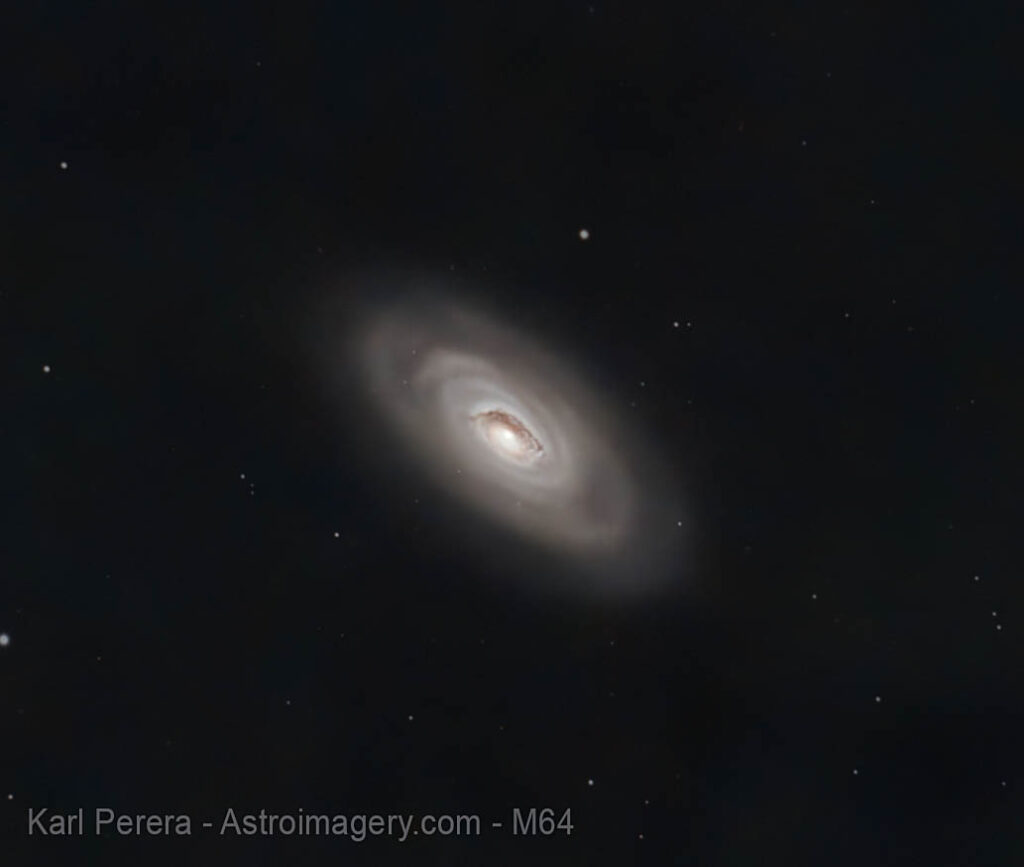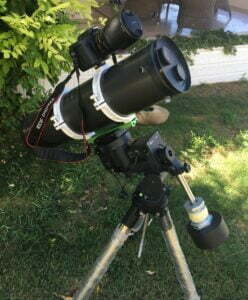Table of Contents
Recently, I spent two whole nights taking pictures of the Black Eye Galaxy (M64). The result after stacking 372 images, each with a two-minute exposure time (a total of 12.4 hours), is what you see here:

I think I am pretty happy with this result! What do you think?
It was a moderate target to image, probably not for beginners as it was so small in the field of view. Blown up, I got good resolution and some good colour. I’d love for you to tell me what you think of my picture. Add your comments below. I managed to capture the interesting central eye part of the galaxy with nice detail.
What is the Black Eye Galaxy?
The Black Eye Galaxy, also known as M64 or NGC 4826, is a spiral galaxy with a dark band of dust around its bright core. It is located 17 million light-years away in the constellation Coma Berenices. Edward Pigott first discovered it in 1779, and Johann Elert Bode and Charles Messier confirmed it later.
The diameter of the black eye galaxy has been estimated to be about 51, 000 light years.
It contains an estimated 100 billion stars!
Another interesting fact about this galaxy is that the gas in the outer regions rotates in the opposite direction to that in the inner regions. This may be the result of a past merger with another galaxy.
The galaxy has a very high rate of star formation. This is especially true in the outer spiral arms, where the younger stars appear blue. Stars are also forming in the area between the two disks that rotate in opposite directions. Gases in this area are compressed and areas of pink hydrogen gas form clouds that also glow with the light produced by the formation of stars. The result is a spectacular site!
The galaxy also forms part of the Virgo cluster but has far more dust and gas than other galaxies nearby.
Because of its unique look and structure, the Black Eye Galaxy is an interesting source of study for researchers and scientists.
The central black part of the galaxy which gives it its name was discovered to be a huge cloud of carbon particles which contrasts against the brighter inner area close by. This discovery was made by observing the galaxy with the Hale 200-inch telescope in 1948!
Why is it called the Black Eye Galaxy?
The reason it is called by this name is because of the dark dust lane that appears in the central area of the galaxy.
When I first saw this galaxy I thought it looked completely unique. The most obvious feature, the black eye in the central part of the galaxy, struck me immediately. The name does seem to describe what we see. Who gave the Black Eye Galaxy its name?
William Herschel was the first person to observe the black eye and gave the galaxy its name in 1785. This was six years after it was first discovered.
What scientific research has been carried out on the Black Eye galaxy?
Scientific research is ongoing on the Black Eye Galaxy. The telescopes that can be used for this study include the James Webb Telescope, Hubble and the Chandra X-Ray Observatory.
One of the most studied features of this galaxy is the dark dust lane at the centre. Scientists have spent a lot of time trying to understand the composition of this part of the galaxy and how it formed.
Another area of study for this galaxy has been the movement within the galaxy especially how different parts of the galaxy move in opposition to each other. Using computer simulations scientists believe that the opposite movement of the inner and outer parts of the Black Eye Galaxy are due to an earlier collision and merger of two galaxies.
Rubin et al (1965) carried out scientific research into the movement within the Black Eye Galaxy. They measured the mass and the rotation of the inner areas of the galaxy. This was early scientific research and this study into M64 continues today.
The bulging centre of this galaxy may contain a massive black hole which is of huge scientific interest.
The galaxy has also been studied to help answer questions about dark matter and whether it is present in the galaxy. In this article by Chang (2024), it is said that dark matter can be found between visible spiral arms in galaxies like the Black Eye Galaxy. Therefore, dark matter is believed to explain the shape and formation of galaxies.
Chang claims that the dark dust lane and other areas in the Black Eye Galaxy are evidence of dark matter.
In this study by Vega and Sanchez (2010) based on observational scientific research on the surface gravity of M64, the Black Eye Galaxy, the calculations suggest the presence of dark matter.
The Gear I Use to Capture Galaxies:
This is the equipment I used to create this image:
- Telescope: Celestron 130 SLT Optical Tube Assembly
- Mount: Ioptron CEM26 equatorial mount.
- Guide scope: 60mm SV Bony SV306 Guide scope and SV301 Camera.
- Camera: ZWO ASI533 MC PRO
- Lenovo Yoga 520 laptop
Shop at Amazon: 60mm SV Bony SV306 Guide Scope The one I use. Approx. $90
I get a small commission if you buy through this link.
The universe is not only stranger than we imagine, but also than we can imagine.
– J.B.S. Haldane
The Steps I Take to Edit My Galaxy Photos:
I have a set workflow now that I am using for my astrophotos. It includes the following steps:
- Stack the photos in Siril
- Edit the stacked photo in Siril (Background extraction, colour calibration and reduction of green noise)
- Edit the photo in Photoshop (Stretching the image, star extraction, noise reduction, clarity and saturation, gradient reduction)
For the Photoshop editing workflow, I use several plugins, including GradientXterminator, NoiseXterminator, and StarXterminator, which I have found to be about the best for Photoshop astrophotography editing.
Tips and Tricks for Photographing Distant Galaxies
One major problem with photographing galaxies is that, with the exception of just a few, such as Andromeda, they are very small in the field of view of a telescope. One tip is to use a longer focal length, perhaps 1000mm or more.
I am limited to 650mm, so I just take many images to get the highest quality picture and edit for the best details possible. Then I crop the image, and it zooms in closer. This has worked for me because my camera is of very high quality.
Regarding the camera, use the best one that you can afford. I bought the ZWO 533 MC PRO, which costs approximately £1000, so it’s not cheap but worth every penny. Here are some tips about buying a cheap camera for astrophotography.
You definitely also want to take longer exposures to capture the finer details, such as the faint arms of a galaxy. I tend to take exposures of about 6 minutes, but you need both a high-quality equatorial mount and a guidescope.
Another tip is to use the right filter, and in some cases, the best is to use no filter at all. Any filter will cut out some parts of the light spectrum. Galaxies are usually broadband targets, and I have used my Optolong L Pro filter to good effect. Learn more about astrophotography filters here.
I have tried no filter, but this does depend on your light pollution and editing skills. With more light pollution, you will need better editing skills because you will have to remove the light you don’t want to increase the contrast of the galaxy and bring out the finer details.
As with most things in astrophotography, you should always experiment and vary your exposure time, try different or no filters, and so on. You’ll discover what works best for your location, experience, and equipment.
Try using my long exposure calculator to work out what lengths of exposure might work for you.
Conclusion: My Experience Photographing the Black Eye Galaxy
The night sky is a dignified face of eternity.
– Henry David Thoreau
During galaxy season, there is little choice but to photograph the interesting galaxies out there. And there are so many! I started with the most well-known and those whose appearance intrigued me. Photographing galaxies not only gives me some variety, but it also challenges me in different ways compared to capturing nebulae. I always enjoy a challenge!
I also wanted to test my new camera, the ZWO 533MC PRO, on this type of deep sky object before I changed to photographing the nebulae that decorate the sky during the summer evenings. These are my favourite objects to image! Anyway, back to this particular galaxy.

In the above picture, you can see my setup with a DSLR camera. I replaced this camera with my newer ZWO ASI533 MC PRO to take even better photos of galaxies.
I enjoyed photographing this object; it was challenging but not too difficult. I had expected it to be more difficult to capture the details of the eye and the brownish colour I was looking for. However, I made sure to capture 12 hours of exposure time to ensure that when I cropped the final photo, the details would shine through.
I think I can say that the various galaxies I captured in 2023 were the best shots I have managed so far, and they gave me a sense of satisfaction. As always, galaxies are awe-inspiring objects because they put everything into perspective. They are so far away (millions of light years)! What you see above in my image is how it looked 17 million years ago! This gets you wondering about the amazing achievement of capturing this fantastic object.
My experience of capturing this beautiful galaxy brings questions to my mind and causes me to wonder if there is life in those many stars that make up my image. Is there someone looking back in time at our Milky Way and experiencing the same amazement that I have? Is there an alien astrophotographer out there photographing our home galaxy?
Thanks for reading this. I hope it inspires you to go out and start photographing galaxies in your own backyard. It’s a wonderful hobby; go on, give it a try!
References
Chang, Y.-F. (2024). Possible Distributions of Negative-Dark Matter in Various Galaxies, and New Research for Some Peculiar Galaxies. European Journal of Theoretical and Applied Sciences, 2(1), 458-467.
de Vega, H. J., & Sanchez, N. G. (2009). Constant surface gravity and density profile of dark matter. arXiv preprint arXiv:0907.0006.
Rubin, V. C., Burbidge, E. M., Burbidge, G. R., & Prendergast, K. H. (1965). The Rotation and Mass of the Inner Parts of NGC 4826. Astrophysical Journal, vol. 141, p. 885, 141, 885.









